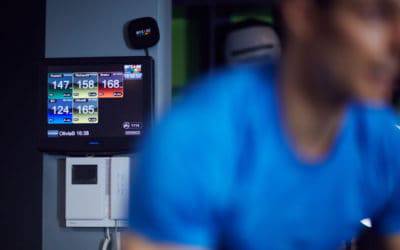If you are currently training with us or have trained with us previously, you’ll know that we use MyZone belts in our training to gage intensity of the workout. The beauty of the MyZone belt is that although it gives a reading as a number, it links it to a colour to make it even simpler to read. But what do the numbers and therefore the colours actually mean? The aim of this article is to inform on just that question.

First of all, we need to understand what number the percentage is actually based off. It is a percentage of your maximum heart rate (MHR). This is the most amounts of beats your heart can do in a specific amount of time. Usually this is measured in beats per minute (BPM). Why does this matter? Heart rate is closely related with intensity. Heart rate increases linearly with intensity, which means it would be fair to say, max heart rate would occur at maximum effort.
How is the maximum heart rate calculated? This is predicted using the formula 220 minus your age. For example, for a 27-year-old, their MHR in BPM would be 193. Of course, as with any formula of this nature, we have to account for inaccuracies. Usually this formula can be up to 10 BPM out.
THE GREY ZONE – 50 to 59%
Although the first stage, this doesn’t mean complete rest. This is going to be above what your normal resting heart rate would be, but not by a lot. Typically you’d get to this during a brisk walk on a flat surface or during dynamic stretching based exercises. You’d also expect to get down to this after recovery has been completed between sets.
THE BLUE ZONE – 60-69%
This is where the aerobic system (utilises oxygen for performance) are going to have to start picking up in order to deliver blood and therefore energy to the working muscles. Work done here will provide a huge benefit to heart and lung health. This is still not going to be intense, although it could be hard for fairly new trainees. At this stage you’d expect to feel a light sweat. You’d also sit at this during some kind of active recovery. For example, completing mobility exercises between your heavier sets.
THE GREEN ZONE – 70-79%
At this level, you’d feel like on a scale of 1/10 of how hard you are working, you’d be at a 7/10. You’d likely hit this in a set of a weight lifting exercise where you could complete 15 repetitions. Although intensity is picking up, this is still going to rely heavily on the oxidative (aerobic) energy system, and therefore won’t give a huge ‘burn’ in the muscles.
THE YELLOW ZONE – 80-89%
You’d expect to get to this during or after a set of a weight lifting exercise where you could only complete 6-10 repetitions. At this point the body can’t rely on purely oxygen-based energy systems to fuel exercise. You’d expect to ‘feel the burn’ when your heart rate is at this level.
THE RED ZONE – 90-99%
A disclaimer: after a few months of training, you’ll find it very hard to hit this in one of our sessions. This is more likely hit on all out exercise. Think weights that you could only lift for 1-5 reps or sprinting as fast as you can. It’s associated with purely maximal effort.
Things to remember
- When we lift weights, the muscular tension restricts blood flowing in to the muscle. This tends to result in a delayed jump in heart rate AFTER the exercise is finished.
- As we progress through the workout, and begin to sweat, your heart rate will stay elevated to aid with sweating. This means estimations will be slightly off or you won’t return to grey during the workout.
- Your oxidative system takes a while to get the ignition going. This means at the start of exercise it will take several minutes for your heart rate to increase. This is also why at the start of exercise we tend to ‘feel the burn’ with low intensity exercises.
- You DO NOT need to, nor should you, spend much time in red. This can lead to fatigue over subsequent days and workouts. Working out is not about going all out all the time, in fact you rarely should go ‘all out’. Training needs to be smart and have planned spikes in intensity (that’s why we’re here!).
Other Uses
Because recovery relies on blood flow to and from the muscle, we can use the heart rate to monitor when you are ready to lift again. When we drop back to a low blue or grey, this can be a sign that the heart is not having to work as hard to deliver blood to the muscle, meaning it’s recovered (or at least partially).
Your heart rate can tell us if you are over trained or ill. Typically, inflammation in the body requires increased blood flow. The result is an elevated heart rate at rest. Typical resting heart rate is approximately 65 bpm in both men and women but more active people can be as low as 49 to 55 bpm.
In Conclusion…
The belts provide both your trainer and you with an accurate measure of how hard you are working. Doing so allows for smart programming that won’t lead to over training. Equally, it won’t let you under train either.

